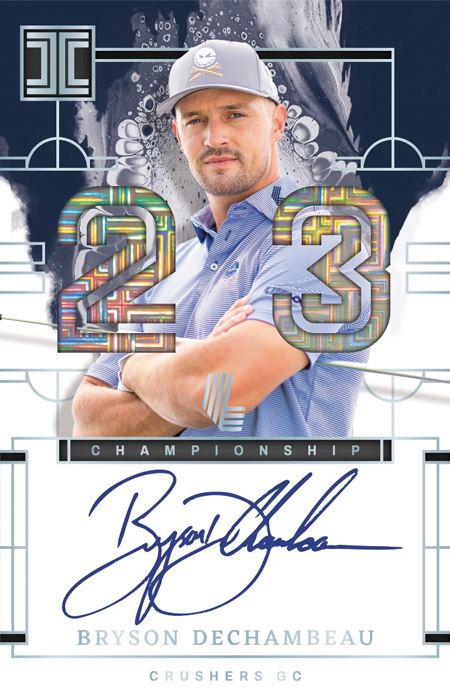Just about every red-blooded American kid took a spin through collecting baseball cards at one time or another. From picking up packs in convenience stores, to checking out card shows or popping into your local card shop, ripping packs and seeing our heroes immortalized in card form was a great pastime among friends.
Over the last several years, there has been a significant increase in those getting back into the hobby. Having taken a significant downturn in the mid 1990s due to overproduction, which is now referred to in the industry as the “junk wax era,” card collectors abandoned the hobby once they discovered that their investments in cards weren’t worth the cardstock they were printed on. Sure, there are still plenty of nostalgia cards that are fun to look at, like the Ken Griffey Jr. rookie card, the notorious Bill Ripken error card with a nasty word on the knob of his bat, or the Bo Jackson “Bo Knows” card where he’s wearing the shoulder pads with the bat across his shoulders. Unfortunately, those of us who felt our potential retirement was sitting in our closet are probably going to have to keep working.

Fast forward to 2020. The COVID 19 pandemic hit hard. It forced people away from their jobs, indoors and trying to discover new ways to pass the days as we tried to make our way through the uncertainty and isolation. Many collectors re-visited collecting, digging old cards out of closets and attics, and thumbing through them to see what they have. Buying and investing in new cards is also something that could be done from the safety of your home, with cards being purchased and shipped directly or bought online through what are known as “card breaks.”
“I’ve been with Panini for 14 years, and we have seen the growth of the marketplace and who is collecting and why they’re collecting,” said Jason Howarth, the Senior Vice President of Marketing and Athlete Relations with Panini America. “We saw the rise of the hobby with the case breakers, and we wanted to expand the marketplace on a global level, so that’s why we stepped in and launched our social platforms in China in 2019 and our direct-to-consumer platforms in China in 2020. We wanted to expand the marketplace from a global point of view.”
A study from 2022 estimated the sports card industry generated around $12.6 billion, with estimates for the market to surpass $23 billion by 2030. With a multitude of companies selling cards with loads of variations, relics, short prints, and even autographs, these are not the cards you ripped 30 years ago.
Graded cards and one-of-a-kind cards, known as 1/1’s, can go for big bucks. Companies like PSA, Beckett and SGA grade cards on a scale of 1-10, based on condition, centering, corners, color and other factors. On PSA’s website, they describe a PSA 1 grade as having “defects may have advanced to such a serious stage that the eye appeal of the card has nearly vanished in its entirety. A Poor card may be missing one or two small pieces, exhibit major creasing that nearly breaks through all the layers of cardboard, or it may contain extreme discoloration or dirtiness throughout that may make it difficult to identify the issue or content of the card on either the front or back. A card of this nature may also show noticeable warping or another type of destructive defect.”

A PSA 10, or “Gem Mint,” is described as a “virtually perfect card. Attributes include four perfectly sharp corners, sharp focus and full original gloss. A PSA 10 card must be free of staining of any kind, but an allowance may be made for a slight printing imperfection, if it doesn’t impair the overall appeal of the card. The image must be centered on the card within a tolerance not to exceed approximately 55/45 to 60/40 percent on the front, and 75/25 percent on the reverse.”
To understand collecting, we need to dive into the kinds of boxes available for purchase and the platforms on which they are sold. With industry leaders like Topps, Panini and Upper Deck offering multiple releases of baseball, basketball, football, hockey, and even golf cards, every sports fan can find something that is affordable for beginners, or pricier and more exotic. From retail and hangar boxes sold at big box stores like Target, Walmart and Best Buy, to hobby boxes at local card shops or online, there are a variety of ways to enjoy the hobby based on your budget and what cards you may be chasing.
Topps, for example, will have about a dozen releases in 2024, from their affordable and collectible Series 1, Series 2 and Big League to their high-dollar Chrome Black, which is chock-full of color variation refractors, inserts and highly sought-after autograph cards.
Panini, another wildly successful manufacturer of cards, will also drop dozens of releases of NBA, NFL, MLB, racing and WWE cards in 2024, with collectors seeking rare parallels that can be worth thousands. One card collectors are chasing in 2024 is anything Victor Wembanyama, as the San Antonio Spurs rookie sensation embarks on what many feel should be a long and successful career. One Wembanyama Black Prism 1/1 was pulled just weeks ago by NorCal Sports Cards during a break and was sent and graded by PSA at a 10. This card could easily fetch up to $1,000,000 should it hit the auction blocks. It is a once-in-a-lifetime pull.

While modern cards don’t generate the same excitement and value as some of the vintage lots, there are plenty of modern cards that have substantial value among collectors. For example, a Mike Trout 2009 Bowman Superfractor Auto 1/1 could be valued around $400,000 today, but the current owner seems okay holding the card in hopes that it will one day value around the same as a vintage Mickey Mantle card. Other modern cards, like Tom Brady 2000 Rookie Ticket card or LeBron James’ 2003 NBA Logoman card, also value in the mid to high six figures and could potentially continue to increase in value.
Vintage cards are considered to be anything pre-1980. The arguable holy grail of cards is the 1952 Topps Mickey Mantle No. 311. Although this isn’t Mantle’s rookie card (that would be a 1951 Bowman), this card is the most important card ever produced and has collectors routinely checking granddad or dad’s old card collections and checking out estate sales just praying they might discover one.
The Mantle is so desirable among collectors, lowly graded ’52 Mantle cards routinely go for thousands of dollars. According to PSA’s website, the ’52 Mantle can be worth almost $15,000 in a PSA 1, $175,000 for a PSA 6 and can venture into the seven figures for those graded 8, 8.5 or 9.
The finest Mantle ever graded is a PSA 9.5 and sold just two years ago for a whopping $12.6 million, which shattered the previous record for any sports card or piece of memorabilia. It is considered the finest example of the ’52 Mantle.
Established in 1976, Heritage Auctions is the single-largest collectibles auctioneer and third-largest auction house in the world. Heritage sold the 9.5 Mantle just mentioned and deals in high-end memorabilia. Heritage has a flagship location here in Dallas, and they feature some of the most sought-after and collectible items on the planet. They specialize in relics like rare currency, coins, contemporary artwork, comic books and comic art, fine and rare wines, historical and political items … and they are one of the most respected and complete auction houses when it comes to sports cards and memorabilia.
Their latest auction, which wrapped last month, sold close to $60 million in rare cards and memorabilia. This included another fantastic 1952 Mantle card, which is SGC graded to 7.5, as well as a game-worn Sandy Koufax jersey and a spectacular photo-matched, game-used 1920 Walter Johnson Washington Senators jersey.

The Mantle card ended up selling for $564,000 and the Walter Johnson jersey went for $2.01 million. So, you can see the kind of money we are talking about here. There is a tremendous market for memorabilia, and the cash behind the scenes is staggering. As if this auction wasn’t mind-blowing enough, Heritage recently announced their Summer Platinum Night Sports Auction, which will take place from August 23-25 and will feature what will likely become the most expensive piece of sports memorabilia ever sold.
Baseball fans know the name Babe Ruth. The “Sultan of Swat” is known for his 22 seasons in the Major Leagues, many of which were with the iconic New York Yankees. Ruth was a seven-time World Series champion, held the all-time home run record of 714 until it was broken by Hank Aaron in 1974. Those who love baseball are undoubtedly familiar with another of Ruth’s most iconic moments, and that is his 1932 World Series Game 3 “called shot” off Chicago Cubs hurler Charlie Root.
Ruth stepped to the plate in the fifth inning and seemingly gestured to Root that he intended to hit a home run, which he then accomplished with a towering shot to center field. The episode only further bolstered Ruth’s mega-stardom and became one of the most immortal moments in the history of baseball. Video evidence confirmed Ruth did, in fact, point, but many argue that he wasn’t exactly calling his shot. Regardless of whether you believe Ruth actually did call a homer, it still remains one of the most discussed moments in sports history.
Now, the famous No. 3 jersey Ruth wore in Game 3 of the 1932 series, which has been meticulously photomatched, will go up for auction at Heritage, with some experts estimating the item could sell for as much as $30 million.

Their upcoming Summer Platinum Night Sports Auction will likely be one of the most successful sports memorabilia auctions in history, with an early estimate of around $80 million in total sales. Sure, the Ruth jersey will get a lot of attention in Heritage’s upcoming summer auction, but they also have a 1938 game-worn Lou Gehrig jersey that could fetch as much as $7,000,000 and a Jackie Robinson game-worn Brooklyn Dodgers jersey valued at around $6,000,000. Not too shabby if you love baseball collectibles.
While it may seem like the world of bidding on items at Heritage is completely unattainable for the common man, that’s not at all the case. Yes, some items are for the uber-wealthy, but regular Joe collectors can find items that are actually very reasonable. Sure, you aren’t going to walk away with a Michael Jordan rookie card graded 10 on the cheap, but if you are looking for some conversation piece cards or something for your personal collection that will turn heads, you can find vintage items that start as low as just a few bucks and go from there. Just last month, Heritage featured a 2012 Panini Prizm Mike Trout card graded to 10 for just $103 and a 2017 Patrick Mahomes Elite Draft Picks graded to 8.5 for just $39. They also featured another 1952 Topps Bob Rush card that sold for less than $100. Sure, it’s not the Mantle, but for less than a Benjamin, you can have an authentic card from that iconic set. As you can see, bidding at Heritage isn’t just for the elite.
There are plenty of ways to purchase cards. You can go the auction route mentioned above if you are interested in high-end vintage products, but you can also get boxes directly from the manufacturer or at your local card shop if you are looking for more variety. However, there is another way to buy cards, and that is through what are known as breakers. Essentially a breaker is someone who acquires cards from the manufacturer and then auctions or sells spots for an online stream where they open the boxes.
Breakers are a bit controversial, and you need to be careful who you buy from, as this is a rapidly growing industry, and you need to be aware of feedback the particular seller has received from customers. Breakers can be found on streaming services like YouTube, Twitch or one of the fastest growing and most popular, WhatNot. WhatNot is an app where breakers will open boxes based on bids from those watching the stream. Let’s imagine a breaker is opening several hobby boxes of Topps Black Chrome that we mentioned earlier, a desirable team to get would be the Los Angeles Dodgers, as Shohei Ohtani cards are very collectible and can be very valuable depending on variations. Well, that team may command a hundred dollars or more, and the person who wins the auction gets every Dodgers card from those boxes. The hope is pulling a valuable autograph card or variation card that can be stashed or flipped for a big profit. But at the end of the day, it is a form of gambling, as there are a very limited number of the highly valuable cards, so hitting something of extraordinary value is a longshot. Don’t get me wrong, card breaks can be fun, but this is a high-risk way to enjoy the hobby.

There is also a golf angle to this. Earlier this year, Panini announced a multi-year deal with the LIV Golf Tour, which opened the door to Panini’s first-ever golf release.
“As we started to dig into the idea, it presented some challenges, but we also felt that there is a connection there between the collectors and the team aspect that LIV Golf provides,” says Howarth.
Panini’s LIV release sold out in just days, with the parallel versions gone in just a matter of hours. Some of the parallels and autos include Bryson DeChambeau, Dustin Johnson and other LIV superstars like Sergio Garcia and Brooks Koepka.
“To be honest, I forgot we had launched them on the site, but then I got an email from an associate that deals with our direct business, and he told me the parallel versions were going fast,” Howarth added. “If you think about it, there are a lot of those guys who have never had a card. Guys like Jon Rahm or Dustin Johnson have never had a card, and it has been almost 15 years since Phil Mickelson has been on a card, so I think there was a lot of excitement from the collector.”
Although you may have missed out on the initial release, Panini is planning on additional LIV releases in the near future, including the Impeccable line of cards, which will feature more fun and interesting inserts like the “Precious Metals” cards which will feature one ounce of real silver.
“Impeccable gives us the opportunity to add those tournament used bits of memorabilia to the cards and give them a great look and some real value. We really look forward to getting them to the public later in the year.” Howarth says.
In addition, Upper Deck did a PGA TOUR release this year, with Young Guns cards that were very desirable, including up-and-coming stars like Will Zalatoris, Viktor Hovland and even John Daly II, to go along with base set cards featuring Tiger Woods, Justin Thomas and Collin Morikawa. There are also short print and special cards like the Brush Strokes series that appear in one of about 5,000 hobby packs, that have greats like Tiger, John Daly, Gary Player and Michelle Wie West.

If we return to Heritage momentarily, they also have a very special golf item in their upcoming summer auction alongside the Ruth, Gehrig and Robinson jerseys. A set of 1950’s clubs once used by President Dwight Eisenhower … estimated value, $80,000. Pretty cool.
The hobby is constantly evolving. From breakers to eBay and other auction sites like Heritage, there are lots of ways to consume, view and purchase cards and collectibles. For me, there is something still very cool about taking a trip to your local card shop and talking with the people who work in the industry. Go check one out … attend a card show … buy some singles for your own personal collection. Sure, you may not be able to afford the ’52 Mantle, but there is plenty of enjoyment in buying some cheap cards and ripping them yourself, with friends, or with your kids.
Now, I just need to add that Nolan Ryan rookie card to my collection.